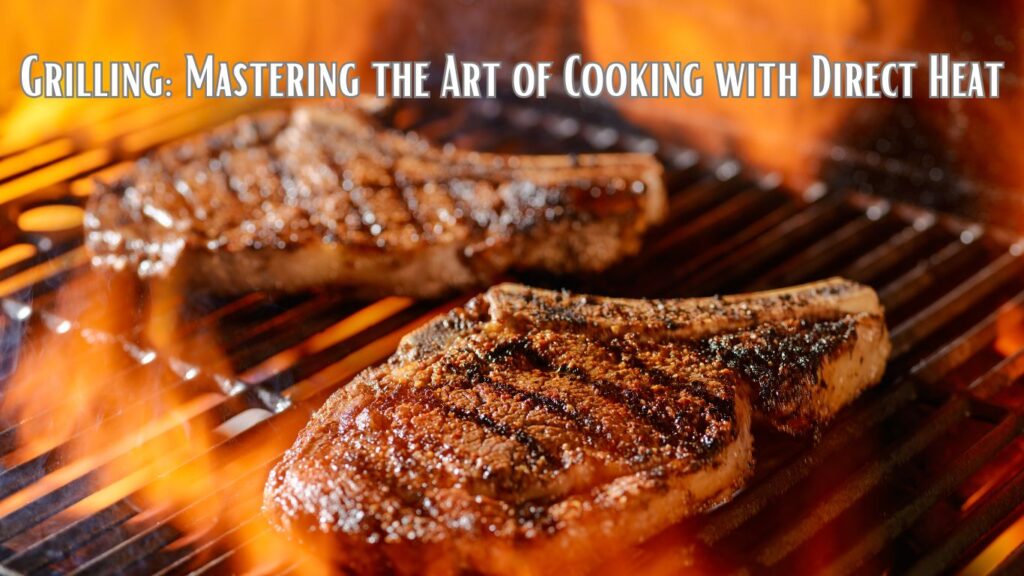We use affiliate links. If you purchase something using one of these links, we may receive compensation or commission.

Discover the secrets of grilling, a timeless cooking method that uses direct heat to infuse food with unique smoky flavors and a perfect char.
Introduction: Grilling, a culinary technique passed down through generations, offers a distinct way to cook food by infusing it with unique smoky flavors. This method involves cooking food over a direct heat source, typically an open flame, which imparts a smoky taste and a charred exterior—a combination that many find irresistible.
What is Grilling?
Grilling is a rapid, dry-heat cooking method that harnesses significant amounts of direct radiant heat. Unlike frying, which relies on direct conduction heating, grilling uses thermal radiation. This method can often reach temperatures exceeding 260°C (500°F), making it a swift process that demands careful attention to prevent overcooking.
The Science Behind Grilling
At the heart of grilling’s appeal is the Maillard reaction, a chemical process that occurs when proteins and sugars in food brown, creating a rich, complex flavor profile. This reaction typically happens when foods reach temperatures above 155°C (310°F), which is easily achieved during grilling. The result is a deliciously browned and flavorful exterior that enhances the overall taste of the food.
Grilling vs. Other Cooking Methods
Grilling is often confused with barbecuing and smoking, but there are distinct differences:
- Barbecuing involves slow cooking over low, indirect heat for extended periods.
- Smoking uses wood chips to infuse a smoky flavor into the food.
- Grilling, on the other hand, is characterized by its high heat and quick cooking times.
Types of Grills
Grills come in various forms, each powered by a different fuel source, including gas, electricity, charcoal, or wood. Each type of grill offers a unique experience and flavor:
- Gas Grills: Provide convenience and control, perfect for those who prefer a hassle-free grilling experience.
- Electric Grills: Suitable for indoor use or areas where open flames are prohibited.
- Charcoal Grills: Impart a deeper smoky flavor, ideal for those who love traditional grilling.
- Wood Grills: Offer the most authentic taste of fire-cooked food, perfect for outdoor cooking enthusiasts.
Grilling Techniques
There are several grilling techniques, each suited for different types of food:
- Direct Heat Grilling: Ideal for quick-cooking items like vegetables, fruits, and thin cuts of meat. This method involves placing the food directly over the heat source.
- Indirect Heat Grilling: Better for larger, thicker cuts of meat that benefit from slower, more even cooking. This method involves placing the food away from the direct heat source.
- Smoking: Involves using flavored wood chips to add a smoky taste to the food, suitable for meats and fish.
Benefits of Grilling
Grilling offers numerous benefits, making it a popular cooking method:
- Flavor: The high heat of grilling enhances the natural flavors of food, creating a deliciously charred and smoky taste.
- Health: Grilling can be a healthier cooking method as it allows fat to drip off the food, reducing overall fat content.
- Versatility: From vegetables to meats to fruits, grilling can be used to cook a wide variety of foods.
- Social Aspect: Grilling is often a social activity that brings people together, creating memorable experiences.
Tips for Perfect Grilling
To master the art of grilling, consider these tips:
- Preheat the Grill: Always preheat your grill to the desired temperature before adding food.
- Clean the Grill Grates: Keep your grill grates clean to prevent sticking and ensure even cooking.
- Oil the Food, Not the Grates: Lightly oil your food to prevent sticking and enhance flavor.
- Use a Meat Thermometer: To ensure your meat is cooked to the desired doneness, use a meat thermometer.
- Rest the Meat: Allow grilled meat to rest for a few minutes before serving to retain its juices.
Conclusion
Grilling is not just a cooking method; it’s a joyous tradition that brings people together. Whether it’s the sizzle of steaks on a hot grill or the aroma of charred vegetables, grilling has a way of turning a meal into a memorable event. With the proper techniques and a bit of practice, anyone can master the art of grilling and savor the delicious rewards it brings.
What is the best type of grill for beginners?
Gas grills are often recommended for beginners due to their ease of use and control over temperature.
How do I prevent my food from sticking to the grill?
Ensure the grill grates are clean, and lightly oil your food before placing it on the grill.
Can I grill indoors?
Yes, electric grills are suitable for indoor use and are a great alternative when outdoor grilling is not possible.
What is the Maillard reaction, and why is it important in grilling?
The Maillard reaction is a chemical process that creates complex flavors when proteins and sugars in food brown at high temperatures, essential for the rich taste of grilled food.
How do I achieve perfect grill marks?
To achieve perfect grill marks, preheat your grill, ensure the grates are clean, and avoid moving the food too often.
Considar Reading:


